Abstract
Aquatic vegetation plays a crucial role in freshwater ecosystems by providing habitats, regulating water quality, and supporting biodiversity. This study aims to monitor and analyze the dynamics of aquatic vegetation in Chimaditida Shallow Lake, Greece, using Sentinel-2 satellite imagery, with validation from field measurements. Data processing was performed using Google Earth Engine and QGIS. The study focuses on discriminating and mapping two classes of aquatic surface conditions: areas covered with Floating and Emergent Aquatic Vegetation and open water, covering all seasons from 1 March 2024, to 28 February 2025. Spectral bands such as B04 (red), B08 (near infrared), B03 (green), and B11 (shortwave infrared) were used, along with indices like the Modified Normalized Difference Water Index and Normalized Difference Vegetation Index. The classification was enhanced using Otsu’s thresholding technique to distinguish accurately between Floating and Emergent Aquatic Vegetation and open water. Seasonal fluctuations were observed, with significant peaks in vegetation growth during the summer and autumn months, including a peak coverage of 2.08 km2 on 9 September 2024 and a low of 0.00068 km2 on 28 December 2024. These variations correspond to the seasonal growth patterns of Floating and Emergent Aquatic Vegetation, driven by temperature and nutrient availability. The study achieved a high overall classification accuracy of 89.31%, with producer accuracy for Floating and Emergent Aquatic Vegetation at 97.42% and user accuracy at 95.38%. Validation with Unmanned Aerial Vehicle-based aerial surveys showed a strong correlation (R2 = 0.88) between satellite-derived and field data, underscoring the reliability of Sentinel-2 for aquatic vegetation monitoring. Findings highlight the potential of satellite-based remote sensing to monitor vegetation health and dynamics, offering valuable insights for the management and conservation of freshwater ecosystems. The results are particularly useful for governmental authorities and natural park administrations, enabling near-real-time monitoring to mitigate the impacts of overgrowth on water quality, biodiversity, and ecosystem services. This methodology provides a cost-effective alternative for long-term environmental monitoring, especially in regions where traditional methods are impractical or costly.
1. Introduction
Aquatic vegetation is a vital component of freshwater ecosystems, providing numerous ecological services, such as habitats for aquatic life, stabilization of shorelines, and regulation of water quality [1,2]. Aquatic vegetation also plays an essential role in nutrient cycling, carbon sequestration, and the overall functioning of aquatic environments. Therefore, monitoring and analysis of aquatic vegetation are key components for understanding ecosystem health, particularly in shallow lakes where the vegetation coverage is often more pronounced and sensitive to environmental changes [3]. Changes in aquatic vegetation are often indicative of broader environmental shifts, such as nutrient loading, water temperature fluctuations, and hydrological alterations, making the accurate assessment of these changes crucial for effective lake management and conservation [4,5].
Traditionally, aquatic vegetation monitoring has relied on ground surveys, which are both costly and time-consuming. However, satellite remote sensing offers an efficient, cost-effective, and near-real-time solution for large-scale and continuous vegetation monitoring. Satellite remote sensing technology has revolutionized the way aquatic environments are monitored. With the ability to cover vast areas in a cost-effective and timely manner, satellite imagery has become an invaluable tool for environmental monitoring [6,7]. Among the most widely used remote sensing satellites are the Sentinel-2 missions, which provide high-resolution multispectral images with frequent revisit intervals. Sentinel-2 is an ideal tool for monitoring dynamic phenomena such as aquatic vegetation, particularly in regions where in situ measurements remain challenging or impractical [8,9,10].
Aquatic vegetation could be classified into three main types: Submerged Aquatic Vegetation (SAV), Floating and Emergent Aquatic Vegetation (FEAV), and Algal Blooms (ABs). SAV consists of plants that grow entirely underwater, either without roots or with roots anchored in the sediment. SAV provides habitats, stabilizes sediments, reduces turbidity, and contributes to oxygenation. Commonly, SAV samples thrive in nutrient-rich, clear water. FEAV includes plants that either float on the water’s surface or grow in shallow water with roots submerged. Floating plants derive nutrients from the water, while Emergent plants extend above the surface. FEAV supports aquatic life, mitigates wave action, and helps excess nutrients absorption. ABs occur when algae overproduce, typically due to excess nutrients, warm temperatures, and calm water. These blooms lead to hypoxia, fish kills, and even toxin production harmful for health. They are often driven by anthropogenic factors such as agricultural runoff and industrial discharges. Each type (SAV, FEAV, and ABs) plays a vital role in aquatic ecosystems and is influenced by natural and human factors. Understanding aquatic vegetation types is essential for managing and conserving shallow lakes [11].
This study aims to monitor and analyze the spatiotemporal dynamics of aquatic vegetation in Chimaditida Shallow Lake, located in northern Greece, by utilizing Sentinel-2 satellite imagery time series. This research specifically focuses on the utilization of two well-established vegetation indices, i.e., the Modified Normalized Difference Water Index (MNDWI) and the Normalized Difference Vegetation Index (NDVI), to quantify and track changes in aquatic vegetation coverage and water quantity. These indices are effective in distinguishing between water and vegetation, providing insight into the extent of SAV and FEAV, as well as the overall health of the aquatic environment [9,12].
The MNDWI is handy for highlighting areas of open water and aquatic vegetation by enhancing the reflectance of water bodies. It is a valuable index tool for detecting changes in water levels and identifying submerged aquatic plants [9,13]. Furthermore, the NDVI is a widely used vegetation index that assesses the density and health of vegetation by comparing the reflectance of light in the red and near-infrared spectra [8,9]. By applying both indices to time-series data, this study aims to assess how seasonal and climatic variations influence aquatic vegetation in Chimaditida Lake.
Chimaditida Lake is an ideal case study for this research, due to its ecological importance and vulnerability. As one of the shallow lakes in Greece, it faces a range of pressures from both natural and human-induced factors, such as eutrophication, invasive species, and land-use changes in the surrounding watershed. Furthermore, the lake has been subject to fluctuations in water quality and vegetation cover in recent years, making it a key site for monitoring and understanding spatiotemporal changes [14].
Several recent studies have been conducted to enhance the accuracy of aquatic vegetation monitoring in shallow lakes. For instance, in the study of [15], an automatic SAV classification algorithm was developed based on Landsat imagery, where the thresholds of two key parameters (the floating algae index (FAI) and reflectance in the shortwave-infrared (SWIR) band) are automatically determined. The algorithm was applied to four Yangtze Plain Lakes in China. The mean producer accuracy obtained was 82.9%. Moreover, ref. [16], used Landsat and Sentinel-2 imagery to analyze the phenological characteristics and long-term spatial distribution of SAV in Baiyangdian Lake, China, from 1986 to 2021. The results showed that the analysis of NDVI time series accurately reflected SAV phenology. A decision tree based on the NDVI and MNDWI achieved 89.7% accuracy in identifying SAV. The distribution of SAV showed dramatic changes, with periods of shrinkage, expansion, degeneration, and early recovery, providing valuable insights for ecological restoration and management of shallow lake ecosystems. Accordingly, ref. [17] presented a method to map aquatic vegetation in a large, shallow eutrophic lake in China, named Taihu Lake, using MODIS data from 2003 to 2013. Their approach involves frequency analysis of the FAI to reduce the impact of floating algae on vegetation mapping. Their method was validated against 244 in situ measurements, achieving overall classification accuracies ranging from 73% to 88% (from 2008 to 2012). The aquatic vegetation area varied from 265.94 km2 in 2007 to 503.38 km2 in 2008, with an average of 359.62 ± 69.20 km2 over 11 years. Their findings highlight significant changes in aquatic vegetation distribution during the study period. Moreover, in the study of [18], the performance of classical and modern Artificial Intelligence (AI) tools was compared, including logistic regression, random forest, and the Segment Anything Model (SAM), for mapping underwater aquatic vegetation (UVeg) using limited annotations in Polyphytos Lake, Greece. This study shows that SAM did much better than logistic regression and random forest when trained on just 40 positive and negative pixel pairs, reaching an F1 score of 86.5% (±4.1%) using airborne images with a 3–6 cm ground sampling distance. However, SAM struggled with space-borne imagery (WorldView-2, Sentinel-2) and did not surpass classical models. Finally, they highlight the challenges of AI tools for UVeg mapping. The authors of [10] used Sentinel-2 satellite images from 2016 to 2022 to monitor spatiotemporal changes of aquatic vegetation in Futou Lake, Hubei Province, China, before and after the removal of a fence. Two vegetation indices, the NDVI and SAVI, were applied using Otsu and manual threshold methods. The results showed that the NDVI and manual division threshold method performed best, achieving 94.44% classification accuracy and a Kappa coefficient of 85.23%. They indicated that the growth of aquatic vegetation occurred in stages, i.e., limited growth in 2016–2017 and rapid growth from 2018 to 2022. The aquatic vegetation was primarily distributed around the former fence and spread to the lake’s core. Dominant species like Potamogeton crispus L., 1753 [19] and Trapa L., 1753 [19] reached a peak in 2021, covering 50.89 km2, requiring moderate control. The significant increase in Potamogeton crispus is attributed to sedimentation and nutrient accumulation. Furthermore, [9] developed a phenology–pixel method to improve the accuracy of remote sensing for SAV detection in Baiyangdian Shallow Lake in China. Using Sentinel-2 images, their method identifies the distribution and growth periods of SAV, distinguishing different plant species and addressing issues like water level fluctuations and mixed-pixel problems. Their method achieved 94.8% overall accuracy, 93.3% user’s accuracy, and 87.3% producer’s accuracy. Their study results provide valuable data for lake ecosystem monitoring and restoration.
By leveraging Sentinel-2 imagery and vegetation indices at Chimaditida Shallow Lake in Greece from 1 March 2024 to 28 February 2025, this research aims to offer a comprehensive approach to monitor aquatic vegetation dynamics over time, providing valuable information on the impacts of environmental changes and human activities on the lake’s ecosystem. The aquatic vegetation of Chimaditida mainly consists of FEAV. Consequently, we developed an algorithm for the automatic monitoring of aquatic vegetation that focuses on distinguishing and mapping two primary classes commonly found in freshwater ecosystems: FEAV and open water (areas without vegetation). Several indicators, obtained through algebraic combinations of satellite bands, were utilized within a multicriteria hierarchical analysis framework, built upon a validated thresholding method. The proposed approach was validated using field measurements obtained from an aerial survey using a DJI Matrice M200 quadcopter UAS with a Parrot Sequoia multispectral camera on board (DJI, Shenzhen, China). This study could contribute to better-informed management practices for Chimaditida Lake, supporting efforts to maintain biodiversity, water quality, and overall ecosystem health. Moreover, the methodology developed in this study can be applied to other freshwater ecosystems facing similar challenges, advancing the role of remote sensing in aquatic ecosystem management and conservation.
2. Study Area
Chimaditida is a shallow lake located in Florina Regional Unit of Western Macedonia, northern Greece. Situated at an elevation of approximately 591 m above sea level, it covers an area of 9.58 km2. The lake is shallow, with a maximum depth of around 2.50 m and an average depth of 1 m. It is part of a complex of interconnected lakes, including Zazari, Petron, and Vegoritida, all situated within the Eordea basin. Chimaditida Lake has the following geographical coordinates: Latitude, 40.595° N; Longitude, 21.567° E [14,20,21].
The surrounding region is rich in biodiversity, hosting numerous plants, animal species, and aquatic organisms. Notably, Chimaditida Lake serves as a crucial breeding ground for the endangered Ferruginous Duck (Aythya nyroca G., 1791 [22]) and provides habitats for various bird species. The area is also recognized as an Important Bird Area (IBA), highlighting its significance for bird conservation [23]. Its biodiversity and ecological balance are vital for local environmental health, making it an important site for monitoring vegetation dynamics and water quality. Moreover, Chimaditida Lake is designated as a Natura 2000 site (GR1340008) (ref. [24], accessed on 7 March 2025), highlighting its importance for biodiversity conservation within the European Union.
Since the lake has fluctuated in size over time, the official shapefile of the lake was received from the Hellenic Data Service website, which was created and last updated on 23 October 2018 (ref. [21], accessed on 7 March 2025). After long-term analysis conducted from 2018 to the present, it has been demonstrated that the shape and morphology of Chimaditida have not changed significantly since October 2018. Consequently, the aforementioned shapefile is recommended for use in this study. Figure 1, designed in QGIS version 3.16.11, shows the location of Chimaditida Lake within Greece and provides an overview of the area of interest.
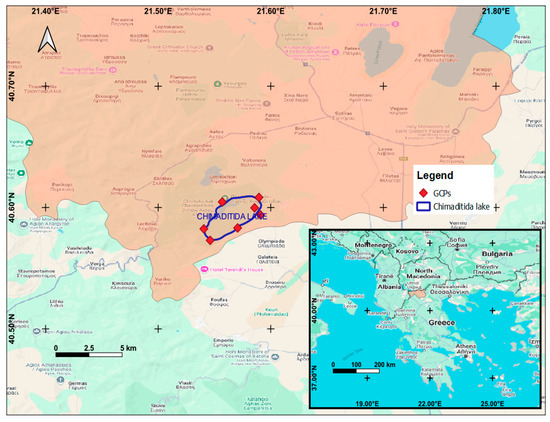
Figure 1.
An overview of the study area examined in this analysis.
According to [25], a distribution of Lemnetea (67%), Potamogetonion (1%), and Phragmito-Magnocaricetea (32%) aquatic vegetation existed in Chimaditida Lake during 2013–2016. General aquatic vegetation categories and dominant species taking place in Chimaditida Lake according to the research of [25] are described in Table 1.

Table 1.
Categories and dominant species of aquatic vegetation in Chimaditida Lake [25].
As aquatic vegetation plays a key role in ecological health, supporting nutrient cycling and providing a habitat for wildlife, this study focuses on monitoring trends in aquatic vegetation using satellite data from Sentinel-2 for a one-year period, namely from 1 March 2024 to 28 February 2025, entirely covering four seasons. In conclusion, it is considered essential to study Chimaditida Lake, because, according to the website of the Hellenic Center for Habitats and Wetlands (EKBY), this lake has a poor overall status in lake classification for the 2012–2015 monitoring period of the EKBY (ref. [36], accessed on 7 March 2025).
3. Materials and Methods
3.1. Sentinel-2 Imagery in Google Earth Engine
Sentinel-2 imagery from 1 March 2024 to 28 February 2025 was processed using the Google Earth Engine (GEE) platform [37]. Sentinel-2 provides multispectral images with a spatial resolution of 10 m, ideal for vegetation monitoring. The imagery was filtered to ensure a cloud cover percentage below 10% for each scene. Sentinel-2 mission consists of two identical satellites operating in sun-synchronous orbits, with a revisit time of five days on the equator and a shorter time toward the poles. The Sentinel-2 Multi-Spectral Instrument (MSI) has 13 spectral bands, including visible light and near-infrared to short-wave infrared spectral bands (ref. [38], accessed on 7 March 2025). The Sentinel-2 data provided by the GEE platform were preprocessed (e.g., radiation correction, orthorectification, and atmospheric correction). A total of 44 scenes of Sentinel-2 images covering Chimaditida Lake for 2024–2025 were selected from the GEE platform.
3.2. Methodology
An innovative approach was applied to Chimaditida Lake. More specifically, two classes were classified, namely open water and FEAV. Four Sentinel-2 bands were used in this study, i.e., B04 (red), B08 (near infrared; NIR), B03 (green), and B11 (shortwave infrared; SWIR). The aforementioned band histograms were analyzed to classify the lake area into open water and FEAV. Since the leaves of FEAV are located on the surface of the water, and its spectral signal does not undergo radiation transmission through the water, the spectral reflectance is still very high [16]. Therefore, the SWIR band was used to separate SAV from FEAV.
Based on Otsu’s algorithm for the automatic extraction of classification thresholds [39], the segmentation thresholds for the NDVI and MNDWI were calculated within the framework of this study (Equation (1) [40], Equation (2) [41]). Since spectral data in remote sensing images changes annually, using a fixed threshold might not apply to other years. Therefore, an automatic threshold extraction method was adopted based on Otsu’s algorithm. This approach divides the image into two regions: the target and the background, making it suitable for calculating thresholds in decision tree classification algorithms [39]. The Otsu threshold method was used to distinguish the NDVI and MNDWI for the study period.
Utilizing aerial survey images from a smaller area to determine and calibrate the NDVI and MNDWI thresholds through Otsu’s algorithm is a strategic approach that effectively addresses local variability, enhances segmentation accuracy, improves computational efficiency, and reduces the impact of outliers or noise. This methodology ensures a more precise and contextually relevant threshold determination, particularly for land cover classes such as vegetation and water. Once determined within the smaller area, the thresholds can be applied to the larger study area with greater confidence, making this approach highly practical for large-scale remote sensing applications.
In the current study, in order to calibrate the NDVI and MNDWI thresholds, four aerial surveys were conducted using a DJI Matrice M200 Unmanned Aerial Vehicle (UAV) quadcopter over the southeastern part of Chimaditida Lake. The acquisition dates were 8 May, 10 June, 26 July, and 12 September 2024. Figure 2 illustrates one of the processed images, which was generated using Open Drone Map version 3.5.4 (ODM V.3.5.4) software. The image, depicted in Figure 2, corresponds to the aerial survey conducted on 12 September 2024, and it delineates the position of the smaller area chosen within the frames of the whole study area.
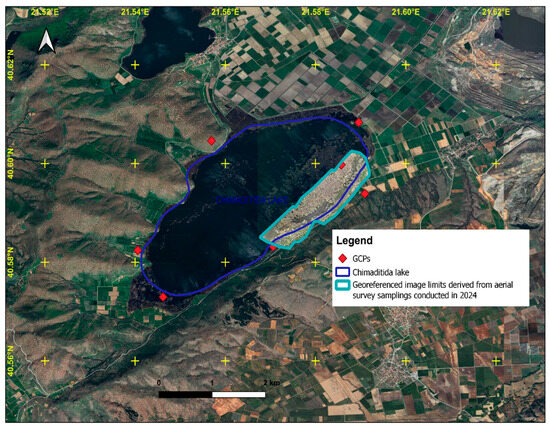
Figure 2.
Image from the aerial survey conducted on 12 September 2024, showing the position of the smaller area selected relative to the entire study area.
As a result, it was found that MNDWI values of both SAV and water were higher than 0, while MNDWI values of FEAV were less than 0. Moreover, NDVI values of SAV were more distinguishable at around 0.3. It is important to note that SAV was found to constitute less than 0.3% of the study area, and due to its minimal contribution, it was not further analyzed. The entire methodology is illustrated in Figure 3.
where NIR is near-infrared band (Band 8), RED is red band (Band 4), GREEN is green band (Band 3), and SWIR is shortwave-infrared band (B11).
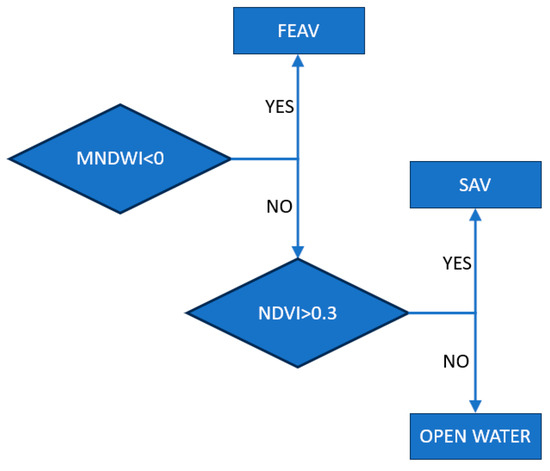
Figure 3.
Thresholds based on Otsu’s method.
3.3. In Situ Data
In this study, an aerial survey was conducted using a DJI Matrice M200 quadcopter UAS with a Parrot Sequoia multispectral camera to validate satellite-derived aquatic vegetation and open water. The camera includes four monochrome spectral bands (green, red, red edge, and near infrared) and an RGB lens, with an external sunshine sensor for lighting correction. The survey occurred at least three times per month from 1 March 2024 to 28 February 2025, with additional flights at the end of each season (31 May 2024, 31 August 2024, 30 November 2024, and 28 February 2025). The image acquisition was done at 120 m above ground level with 80% overlap and a flight speed of 4 m/s. Seven Ground Control Points (GCPs), depicted in Figure 1, were used for accurate exterior orientation, with coordinates surveyed using a Topcon Hiper V Real-Time Kinematic (RTK) Global Navigation Satellite System (GNSS) system. The image processing was completed in ODM V.3.5.4 software, resulting in RGB and multispectral orthomosaics with an average ground sampling distance (AGSD) of approximately 7 cm. As previously noted, the mean water depth of Chimaditida Lake is approximately equal to 1 m, and as a result, several species of FEAV were identified during the aerial survey. Notably, no significant presence of ABs was observed on the water surface in the samples examined. Additionally, due to the shallow nature of the lake, SAV was quite absent. Moreover, it is worth mentioning that the lake bottom was visible to the human eye since the lake is shallow (mean water depth 1 m).
The coefficient of determination (R2) between Satellite-Derived Surface aquatic vegetation (km2) and Observed Surface aquatic vegetation (km2) was found to be equal to 0.88. The values of Satellite-Derived Surface aquatic vegetation (km2) compared to Observed Surface aquatic vegetation (km2) time series are shown in Figure 4. Accordingly, R2 between Satellite-Derived Surface open water (km2) and Observed Surface open water (km2) was calculated to be 0.86 (Figure 5).
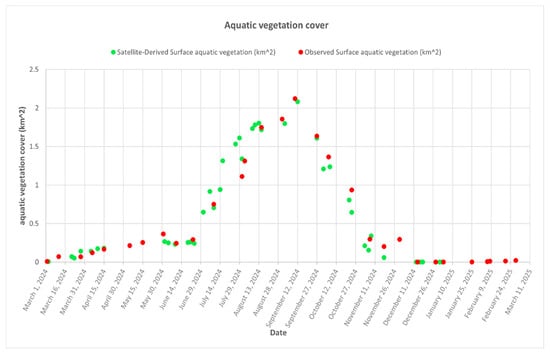
Figure 4.
Values of Satellite-Derived Surface aquatic vegetation (km2) compared to Observed Surface aquatic vegetation (km2) time series.
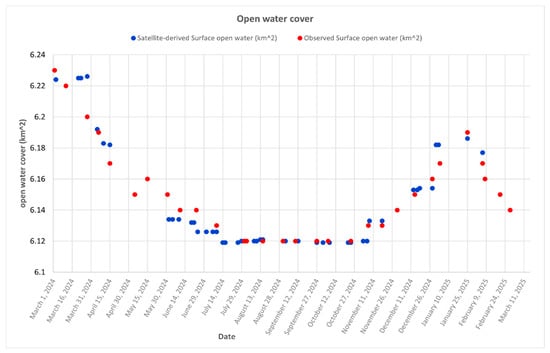
Figure 5.
Values of Satellite-Derived Surface open water (km2) compared to Observed Surface open water (km2) time series.
4. Results
This study proposes a method to classify aquatic vegetation and open water in Chimaditida Lake using all available Sentinel-2 images. In addition, the method proposed in this study considers four Sentinel-2 band histograms (i.e., B04, B08, B03, and B11), which were analyzed to classify the lake area into open water and aquatic vegetation.
To verify the accuracy of the method, approximately 210 aerial images were taken using a DJI Matrice M200 quadcopter UAS with a Parrot Sequoia multispectral camera on board. The aerial images were processed with ODM V.3.5.4 software.
The accuracy assessment was conducted using the overall accuracy (OA), user’s accuracy (UA), and producer’s accuracy (PA) metrics. The OA is determined by dividing the number of correctly classified pixels by the total number of sampled pixels. The PA, also known as precision for each class, is calculated by dividing the number of correctly classified pixels in a specific class by the total number of reference pixels for that class. The PA reflects false-negative predictions and compares the classified map to the producers’ expectations. On the other hand, the UA focuses on false-positive predictions and is calculated by dividing the number of correctly predicted pixels for each class by the total number of pixels classified into that class. The UA shows how accurately each classified pixel on the map represents the actual class on the ground. The OA resulted in a score of 89.31% (Table 2). The classification results, represented in Table 2, were satisfactory in terms of overall performance. In particular, the aquatic vegetation scores were higher than open water, as the producer and user accuracies of aquatic vegetation were 97.42% and 95.38%, respectively.

Table 2.
Comparison of classification accuracy of the aquatic vegetation and open water (PA = producer accuracy; UA = user accuracy; OA = overall accuracy).
The average area of the open water class across all satellite-derived dates was 6.15 km2, of which 0.65 km2 was covered by aquatic vegetation. Given that the Chimaditida shapefile, as described in Section 2, covers an area of 9.58 km2 since 2018, it is evident that the remaining 3.43 km2 has experienced desiccation. Aquatic vegetation peaked with a score of 2.08 km2 on 9 September 2024, while its lowest value of 0.00067694 km2 was recorded on 28 December 2024. A steady decline in the extent of aquatic vegetation began on 7 October 2024. Similarly, for open water, its highest extent of 6.226 km2 occurred on 28 March 2024, while the minimum value of 6.119 km2 was observed on multiple dates throughout July, September, and October 2024.
According to Figure 6, aquatic vegetation in Chimaditida Lake is more abundant in autumn due to several factors that influence plant growth and survival in aquatic ecosystems. For instance, in autumn, temperatures typically start to cool, creating more stable conditions for aquatic plants. Warmer water temperatures in summer can sometimes cause stress for some aquatic species that exist in lakes, like Phragmites australis (common reed), Typha latifolia L., 1753 [19] (broadleaf cattail), Scirpus lacustris L., 1753 [19], various species of Carex L., 1753 [19], and Glyceria maxima (H.) H., 1925 [42,43]. Moreover, autumn often follows a period of increased nutrient runoff, particularly after summer rains. These nutrients (e.g., nitrogen and phosphorus) can boost plant growth, leading to a rise in aquatic vegetation. Additionally, when temperatures drop, some nutrients may become more accessible to plants due to reduced biological activity, creating favorable conditions for plant growth. Furthermore, as depicted in Figure 7, in Chimaditida Lake, autumn represents a period when the water level stabilizes after seasonal changes (such as a summer drought or flooding), allowing aquatic vegetation to spread and thrive.
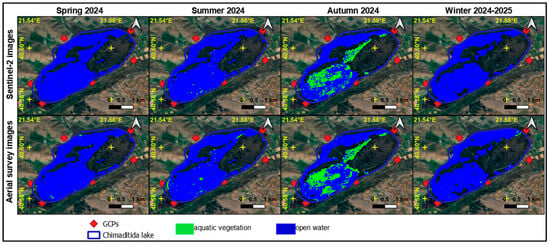
Figure 6.
Aquatic vegetation and open water classification results based on Sentinel-2 and aerial survey images for each season during the study period.
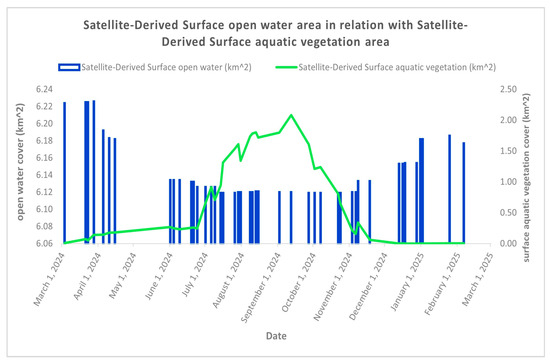
Figure 7.
Temporal changes in Satellite-Derived Surface aquatic vegetation and open water of Chimaditida Lake.
According to Figure 7, water level in Chimaditida Lake remains almost constant, having small fluctuations throughout all seasons. This stability arises from several reasons. Chimaditida Lake has a well-balanced inflow (such as from rivers, streams, or groundwater) and outflow (like evaporation or drainage), ensuring that water level remains steady year-round. This balance prevents large fluctuations despite seasonal changes. Additionally, a hydraulic structure—specifically a sealing embankment and a controllable overflow weir at the lake’s outlet—can regulate the lake’s water management and control its water level.
5. Discussion
5.1. Description and Advantages of Classification Method Described
This study aims to assess aquatic vegetation and open water dynamics in Chimaditida Lake, in Greece, through a comprehensive remote sensing approach, integrating both satellite and UAV-based imagery. Using an equipped DJI Matrice M200 quadcopter, this study sought to classify and monitor the extent of aquatic vegetation and open water over one year, from March 2024 to February 2025. The integration of satellite-derived data (via Sentinel-2) and high-resolution aerial imagery allowed the accurate classification and phenological analysis of the aquatic vegetation, with a focus on both SAV and FEAV.
Our findings demonstrate a high degree of accuracy in classifying aquatic vegetation and open water, as evidenced by the OA of 89.31%, with the UA and PA for aquatic vegetation reaching 95.38% and 97.42%, respectively. This method, based on the combination of Sentinel-2 imagery and UAV-derived orthomosaics, showed a strong agreement (R2 = 0.88) between Satellite-Derived and Observed Surface aquatic vegetation, which aligns well with similar studies in the literature [3,8,9]. However, the specific nature of Chimaditida Lake, with its shallow waters and clear visibility of the lake bottom, presents a unique aspect for remote sensing applications, which will be discussed in comparison with other studies.
Among these study benefits is the higher spatial resolution provided by Sentinel-2 data (10 m), which allows a more precise classification of both aquatic vegetation and open water, particularly in small, shallow lakes. This enhanced resolution improves the detection and delineation of smaller patches of aquatic vegetation and subtle changes in the water body, addressing challenges that satellite imagery with coarser resolution, such as Landsat, might not handle as effectively. While the approach of [15] was promising in classifying SAV, the spatial resolution of Landsat data (30 m) often reduces the accuracy for finer-scale vegetation mapping in shallow lakes. Similarly, in the study of [17] the lower spatial resolution of MODIS (250–500 m) might limit their approach ability to detect fine-scale changes in vegetation. Moreover, in the context of this study, it was observed that aquatic vegetation reached its highest value during the autumn months, coinciding with stable temperatures and increased nutrient availability following summer rains. These findings align with those of [16], who emphasized the role of nutrient influx in promoting vegetation growth. Among this study’s advantages is the focus on a smaller, shallow lake, where high-frequency UAV surveys in combination with Sentinel-2 satellite data allowed for high-resolution, detailed mapping of aquatic vegetation dynamics, while refs. [9,18] provided an approach more suitable for larger lakes. Finally, in this research, the spatiotemporal dynamics of aquatic vegetation in Chimaditida Lake were explored, focusing on natural seasonal changes and water area/level fluctuations. Furthermore, this analysis provides valuable insights into the seasonal patterns of aquatic vegetation, with significant peaks observed during the autumn months, which were attributed to stable environmental conditions such as water temperature and nutrient availability in contrast with other similar studies, i.e., ref. [10], who examined the effects of external management interventions, such as the removal of a fence, on aquatic vegetation in Lake Futou.
In summary, these study results demonstrated seasonal variations in the extent of aquatic vegetation. The highest extent of aquatic vegetation occurred in autumn, a time when temperatures stabilize and nutrient availability is high due to runoff. This seasonal peak in vegetation is consistent with findings from [9,10], which highlight autumn as a critical period for aquatic plant growth due to favorable conditions for nutrient uptake. The slight fluctuation in water levels across seasons, as observed in Chimaditida Lake, also contributes to the stability of vegetation growth, supporting the findings from [16,17] that water level stability plays a significant role in aquatic vegetation phenology. This research could moreover provide valuable insights for Greek and European water and environment management authorities, as it addresses a gap in the existing knowledge. To date, there has been a lack of studies focusing on the dynamics of aquatic vegetation in Mediterranean and European freshwater systems, particularly on the monitoring of SAV and FEAV. By offering a detailed analysis of vegetation patterns, water quality dynamics, and the drivers influencing these systems, this study would contribute to the development of more effective and sustainable water management strategies. Additionally, the findings might inform policy decisions and support the conservation of aquatic biodiversity in the region.
5.2. Uncertainties, Limitations, and Future Recommendations
Despite the promising results, several uncertainties and limitations in this study should be acknowledged. One of the key challenges is the reliance on satellite-derived imagery and aerial surveys, both of which are influenced by environmental conditions such as cloud cover, lighting variations, and atmospheric interference. Although efforts were made to correct these issues (e.g., using the sunshine sensor for radiometric calibration), inaccuracies in atmospheric corrections and image quality still affect the final vegetation classification results. For instance, during cloudy or overcast days, the sensor data may be obscured, potentially leading to misclassification or the underrepresentation of aquatic vegetation.
Another limitation of this study is the spatial resolution of Sentinel-2 imagery (10 m), which, although higher than Landsat imagery, might still miss finer-scale details such as small patches of vegetation or subtle changes in vegetation density, especially in areas with complex aquatic vegetation patterns or high spatial heterogeneity. UAV-based data, although more precise, is limited by flight time and operational constraints, including battery life and weather conditions, which might restrict the frequency of image acquisition in some seasons or environmental conditions.
Regarding future recommendations, it would be valuable to integrate socio-economic and management-related factors, such as water management policies, human activities (e.g., agricultural runoff), and conservation efforts, to better understand the drivers behind aquatic vegetation dynamics. Combining ecological, hydrological, and socio-economic data would contribute to more-effective management strategies for preserving aquatic ecosystems and their biodiversity. Moreover, in future studies, it is recommended to expand the algorithm of this study to deeper or varying-depth lakes containing SAV alongside FEAV. Incorporating a broader classification system that includes both submerged and surface-level vegetation would provide a more comprehensive understanding of aquatic ecosystems. This would not only enhance the insights into overall lake health and biodiversity but also improve the generalizability of the findings to lakes with deeper waters or different types of aquatic vegetation. Such an approach could offer a more holistic view of the ecological dynamics in aquatic environments.
6. Conclusions
This study provides a comprehensive analysis of the spatiotemporal dynamics of aquatic vegetation in Chimaditida Lake, northern Greece, using Sentinel-2 satellite imagery and field validation via aerial surveys. The method applied focused on distinguishing FEAV from open water, utilizing key vegetation indices such as the MNDWI and NDVI. The utility of Otsu’s algorithm for automatic threshold extraction facilitated the accurate classification of FEAV and open water, with high overall classification accuracy (89.31%), and impressive user and producer accuracies for aquatic vegetation (95.38% and 97.42%, respectively).
The analysis revealed that aquatic vegetation in Chimaditida Lake is most abundant in autumn, with a peak of 2.08 km2 recorded in September 2024. This increase is attributed to more favorable environmental conditions, including stable water temperatures, nutrient availability following summer rains, and the stabilization of water levels after seasonal fluctuations. Despite seasonal changes, the lake’s water level remained relatively stable, with small fluctuations observed across the year. This stability, supported by regulated water management and the balanced inflow and outflow of water, has likely contributed to the consistent spread of aquatic vegetation.
These findings highlight the utility of satellite-based monitoring for large-scale, cost-effective tracking of aquatic vegetation dynamics, providing valuable insights for lake management and conservation. The methodology developed in this study contributes to the effective monitoring of Chimaditida Lake’s ecological health and is also applicable to other shallow freshwater ecosystems experiencing similar environmental challenges. Finally, this research contributes to the ongoing efforts to preserve biodiversity, water quality, and ecosystem health in Chimaditida Lake and beyond.
Author Contributions
M.K. and V.A. established the concept and methods; M.K. collected and processed satellite data; V.A. collected and processed field data; M.K. did the overall analysis; M.K. and V.A. wrote the paper. All authors have read and agreed to the published version of the manuscript.
Funding
This research was developed within the framework of the “Nature-Based Solutions for Water Management in the Mediterranean” (NATMED) project, funded from the European Union’s PRIMA Research and Innovation Programme under Grant Agreement No. 2221. The project’s developments provided valuable foundational resources, and the completion of this work was further supported by additional institutional and academic contributions.
Institutional Review Board Statement
Not applicable.
Informed Consent Statement
Not applicable.
Data Availability Statement
The GEE codes developed for this research as well as the ODM Quality Reports are accessible upon request through email to the corresponding author.
Conflicts of Interest
The authors declare no conflicts of interest.
References
- Barko, J.W.; Gunnison, D.; Carpenter, S.R. Sediment interactions with submersed macrophyte growth and community dynamics. Aquat. Bot. 1991, 41, 41–65. [Google Scholar] [CrossRef]
- Bolpagni, R.; Bresciani, M.; Laini, A.; Pinardi, M.; Matta, E.; Ampe, E.M.; Giardino, C.; Viaroli, P.; Bartoli, M. Remote sensing of phytoplankton-macrophyte coexistence in shallow hypereutrophic fluvial lakes. Hydrobiologia 2014, 737, 67–76. [Google Scholar] [CrossRef]
- Liu, B.; Sevick, T.; Jung, H.; Kiskaddon, E.; Carruthers, T. Quantifying the Potential Contribution of Submerged Aquatic Vegetation to Coastal Carbon Capture in a Delta System from Field and Landsat 8/9-Operational Land Imager (OLI) Data with Deep Convolutional Neural Network. Remote Sens. 2023, 15, 3765. [Google Scholar] [CrossRef]
- Zargar, U.R.; Khanday, S.A.; Rather, M.I.; Dar, S.A.; Zargar, N.H.; Mir, A.H. Accelerated eutrophication alters fish and aquatic health: A quantitative assessment by using integrative multimarker, hydrochemical, and GIS modelling method in an urban lake. Environ. Monit. Assess. 2024, 196, 40. [Google Scholar] [CrossRef] [PubMed]
- Kolada, A. The use of aquatic vegetation in lake assessment: Testing the sensitivity of macrophyte metrics to anthropogenic pressures and water quality. Hydrobiologia 2010, 656, 133–147. [Google Scholar] [CrossRef]
- Campillo-Tamarit, N.; Molner, J.V.; Soria, J.M. Remote Sensing Tools for Monitoring Marine Phanerogams: A Review of Sentinel and Landsat Applications. J. Mar. Sci. Eng. 2025, 13, 292. [Google Scholar] [CrossRef]
- Kofidou, M. Involvement of Remote Sensing and GIS in Sustainable Groundwater Monitoring: An Overview. JSM Environ. Sci. Ecol. 2024, 12, 1097. [Google Scholar]
- Tompoulidou, M.; Karadimou, E.; Apostolakis, A.; Tsiaoussi, V. A Geographic Object-Based Image Approach Based on the Sentinel-2 Multispectral Instrument for Lake Aquatic Vegetation Mapping: A Complementary Tool to In Situ Monitoring. Remote Sens. 2024, 16, 916. [Google Scholar] [CrossRef]
- Liang, S.; Gong, Z.; Wang, Y.; Zhao, J.; Zhao, W. Accurate Monitoring of Submerged Aquatic Vegetation in a Macrophytic Lake Using Time-Series Sentinel-2 Images. Remote Sens. 2022, 14, 640. [Google Scholar] [CrossRef]
- Fu, C.; He, B.; Zhou, Y.; Liu, H.; Yang, F.; Song, J.; Cai, H.; Yang, X. Remote Sensing Monitoring of Changes in Lake Aquatic Vegetation before and after the Removal of the Fence Based on Sentinel-2: A Case Study in Lake Futou, Hubei Province. Sustainability 2022, 14, 12478. [Google Scholar] [CrossRef]
- PennState Extension. Available online: https://extension.psu.edu/identifying-aquatic-plants (accessed on 24 March 2025).
- Singh, G.; Reynolds, C.; Byrne, M.; Rosman, B. A remote sensing method to monitor water, aquatic vegetation, and invasive water hyacinth at national extents. Remote Sens. 2020, 12, 4021. [Google Scholar] [CrossRef]
- Khalid, H.W.; Khalil, R.M.Z.; Qureshi, M.A. Evaluating spectral indices for water bodies extraction in western Tibetan Plateau. Egypt. J. Remote Sens. Sp. Sci. 2021, 24, 619–634. [Google Scholar] [CrossRef]
- NATmed. Available online: https://natmed-project.eu/case-studies/lake-system-chimaditida-greece/ (accessed on 24 March 2025).
- Dai, Y.; Feng, L.; Hou, X.; Tang, J. An automatic classification algorithm for submerged aquatic vegetation in shallow lakes using Landsat imagery. Remote Sens. Environ. 2021, 260, 112459. [Google Scholar] [CrossRef]
- Wang, Y.; Gong, Z.; Zhou, H. Long-term monitoring and phenological analysis of submerged aquatic vegetation in a shallow lake using time-series imagery. Ecol. Indic. 2023, 154, 110646. [Google Scholar] [CrossRef]
- Liu, X.; Zhang, Y.; Shi, K.; Zhou, Y.; Tang, X.; Zhu, G.; Qin, B. Mapping aquatic vegetation in a large, shallow eutrophic lake: A frequency-based approach using multiple years of MODIS data. Remote Sens. 2015, 7, 10295–10320. [Google Scholar] [CrossRef]
- Alagialoglou, L.; Manakos, I.; Papadopoulou, S.; Chadoulis, R.T.; Kita, A. Mapping Underwater Aquatic Vegetation Using Foundation Models With Air- and Space-Borne Images: The Case of Polyphytos Lake. Remote Sens. 2023, 15, 4001. [Google Scholar] [CrossRef]
- Linnaeus, C. Species Plantarum; Laurentii Salvii: Stockholm, Sweden, 1753; Volume 2, p. 126. [Google Scholar]
- Petriki, O.; Zervas, D.; Doulgeris, C.; Bobori, D. Assessing the ecological water level: The case of four mediterranean lakes. Water 2020, 12, 2977. [Google Scholar] [CrossRef]
- Hellenic Data Service. HELIX. Available online: https://pubs.hellenicdataservice.gr/dataset/a7723063-0fe2-495f-95e9-afe8d5b441c5/resource/77058481-b5e3-4181-b908-d28df34cd0a2 (accessed on 7 March 2025).
- Güldenstädt, J.A. Reisen Durch den Kaukasus und Georgien in den Jahren 1770–1773; Kaiserliche Akademie der Wissenschaften: St. Petersburg, Russia, 1787–1791. [Google Scholar]
- DataZone by BirdLife. Available online: https://datazone.birdlife.org/ (accessed on 7 March 2025).
- Europian Union. Natura2000. Available online: https://natura2000.eea.europa.eu/ (accessed on 7 March 2025).
- Zervas, D.; Tsiripidis, I.; Bergmeier, E.; Tsiaoussi, V. A phytosociological survey of aquatic vegetation in the main freshwater lakes of Greece. Veg. Classif. Surv. 2020, 1, 53–75. [Google Scholar] [CrossRef]
- Görs, H. Die Pflanzengesellschaften des Brackwassers und ihrer Ufer an der Unteren Elbe. Vegetatio 1966, 13, 123–141. [Google Scholar]
- Cavanilles, A.J. Icones et Descriptiones Plantarum; Ex Regia Typographia: Madrid, Spain, 1799. [Google Scholar]
- Trinius, C.B.; Steudel, E.G. Synopsis Plantarum Glumacearum; J.B. Metzler: Stuttgartiae, Germany, 1840; Volume 1, p. 237. [Google Scholar]
- Tx. Vegetationsbilder aus Mitteleuropa. Vegetatio 1937, 3, 215–229. [Google Scholar]
- Gev. Études phytosociologiques sur la végétation des marais salants. Bull. Société Bot. Fr. 1944, 91, 37–51. [Google Scholar]
- Soó, R. A Magyar Flóra és Vegetáció Rendszertani-Növényföldrajzi Kézikönyve; Akadémiai Kiadó: Budapest, Hungary, 1968; Volume III. [Google Scholar]
- Passarge, S. Zur Syntaxonomie schwimmender Wasservegetation in Mitteleuropa. Mitteilungen Florist.-Soziol. Arbeitsgemeinschaft 1978, 20, 55–76. [Google Scholar]
- Braun-Blanquet, J.; Tüxen, R. Pflanzensoziologische Studien im Naturschutzgebiet “Totes Moor” bei Neustadt am Rübenberge; Abhandlungen des Landesmuseums für Naturkunde Münster; Landesmuseum für Naturkunde: Münster, Germany, 1943; Volume 24, pp. 1–100. [Google Scholar]
- Hadač, E.; Sofron, J. Contribution to the knowledge of aquatic plant communities in Bohemia. Folia Geobot. Phytotaxon. 1980, 15, 123–138. [Google Scholar]
- Soó, K. Beiträge zur Kenntnis der Pflanzenassoziationen Ungarns. Bot. Cent. 1927, 44, 202–212. [Google Scholar]
- EKBY. Hellenic Center for Habitats and Wetlands. Available online: https://wfd.ekby.gr/apotelesmata/taxinomisi-katastasis-limnon/ (accessed on 7 March 2025).
- Gorelick, N.; Hancher, M.; Dixon, M.; Ilyushchenko, S.; Thau, D.; Moore, R. Google Earth Engine: Planetary-scale geospatial analysis for everyone. Remote Sens. Environ. 2017, 202, 18–27. [Google Scholar] [CrossRef]
- Europian Space Agency. Available online: https://sentiwiki.copernicus.eu/web/sentinel-2 (accessed on 7 March 2025).
- Otsu, N. A Threshold Selection Method from Gray-Level Histograms. IEEE Trans. Syst. Man Cybern. 1979, 9, 62–66. [Google Scholar] [CrossRef]
- Tucker, C.J. Red and Photographic Infrared Linear Combinations for Monitoring Vegetation. Remote Sens. Environ. 1979, 8, 127–150. [Google Scholar] [CrossRef]
- Xu, H. Modification of normalised difference water index (NDWI) to enhance open water features in remotely sensed imagery. Int. J. Remote Sens. 2006, 27, 3025–3033. [Google Scholar] [CrossRef]
- Hartman, P. Handbok i Skandinaviens Flora; LuEsther T. Mertz Library: New York, NY, USA, 1820. [Google Scholar]
- Holmberg, N.E. Zur Kenntnis der schwedischen Glyceria-Arten. Sven. Bot. Tidskr. 1925, 19, 105–119. [Google Scholar]
Disclaimer/Publisher’s Note: The statements, opinions and data contained in all publications are solely those of the individual author(s) and contributor(s) and not of MDPI and/or the editor(s). MDPI and/or the editor(s) disclaim responsibility for any injury to people or property resulting from any ideas, methods, instructions or products referred to in the content. |
© 2025 by the authors. Licensee MDPI, Basel, Switzerland. This article is an open access article distributed under the terms and conditions of the Creative Commons Attribution (CC BY) license (https://creativecommons.org/licenses/by/4.0/).